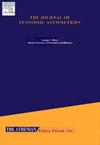Collapsing bubbles in the prices of cryptocurrencies
Q1 Economics, Econometrics and Finance
引用次数: 0
Abstract
This paper investigates the existence of bubbles in the daily prices of the most popular cryptocurrencies, Bitcoin (BTC), Ether (ETH), and Ripple (XRP), employing the recursive methods of Phillips et al. (2015) and Phillips et al. (2011) for testing and date-stamping episodes of exuberant behaviour over a period spanning seven years (2018–2024), including the COVID-19 pandemic crisis (2020–2021). The critical values of the tests are computed through the composite wild bootstrap technique by Phillips and Shi (2020) to make them robust to time-varying unconditional heteroscedasticity and the multiplicity issue in recursive tests. Results indicate that the prices of the most popular cryptocurrencies traded on decentralized ledgers, BTC and ETH, exhibited multiple episodes of exuberant behaviour, unambiguously for BTC and depending on the tests for ETH. Bubbles detected in the prices of BTC were due to the halving of the crypto, to market exuberance and to the pandemic crisis; bubbles detected on ETH prices were due to the launch of NFTs on the Ethereum blockchain, and to the change in investors’ expectations (from exuberant to pessimistic); the change in the stance of monetary policy burst the bubbles of BTC and ETH prices in 2024. No test supports the exuberance of XRP that is traded on a centralized ledger; weekly data confirm the absence of multiple bubbles. By looking at the presence of bubbles in these different digital ecosystems, we also consider how the technological differences can impact, possibly asymmetrically, bubbles' formation.

加密货币价格泡沫破裂
本文研究了最流行的加密货币比特币(BTC)、以太币(ETH)和瑞波币(XRP)每日价格中泡沫的存在,采用了Phillips等人(2015)和Phillips等人(2011)的递归方法,对七年(2018-2024)期间(包括2019冠状病毒病大流行危机(2020-2021)的繁荣行为进行了测试和日期戳。检验的临界值由Phillips和Shi(2020)通过复合野生自举技术计算,使其对时变无条件异方差和递归检验中的多重性问题具有鲁棒性。结果表明,在去中心化分类账(BTC和ETH)上交易的最受欢迎的加密货币的价格表现出多次旺盛的行为,这显然是针对BTC的,取决于对ETH的测试。在比特币价格中发现的泡沫是由于加密货币减半、市场繁荣和流行病危机;ETH价格的泡沫是由于在以太坊区块链上推出了nft,以及投资者预期的变化(从乐观到悲观);2024年,货币政策立场的变化打破了比特币和以太坊价格的泡沫。没有测试支持在集中分类账上交易的瑞波币的繁荣;每周数据证实了多重泡沫的存在。通过观察这些不同数字生态系统中泡沫的存在,我们也考虑了技术差异如何影响泡沫的形成,可能是不对称的。
本文章由计算机程序翻译,如有差异,请以英文原文为准。
求助全文
约1分钟内获得全文
求助全文
来源期刊

Journal of Economic Asymmetries
Economics, Econometrics and Finance-Economics, Econometrics and Finance (all)
CiteScore
4.80
自引率
0.00%
发文量
42
审稿时长
50 days
 求助内容:
求助内容: 应助结果提醒方式:
应助结果提醒方式:


